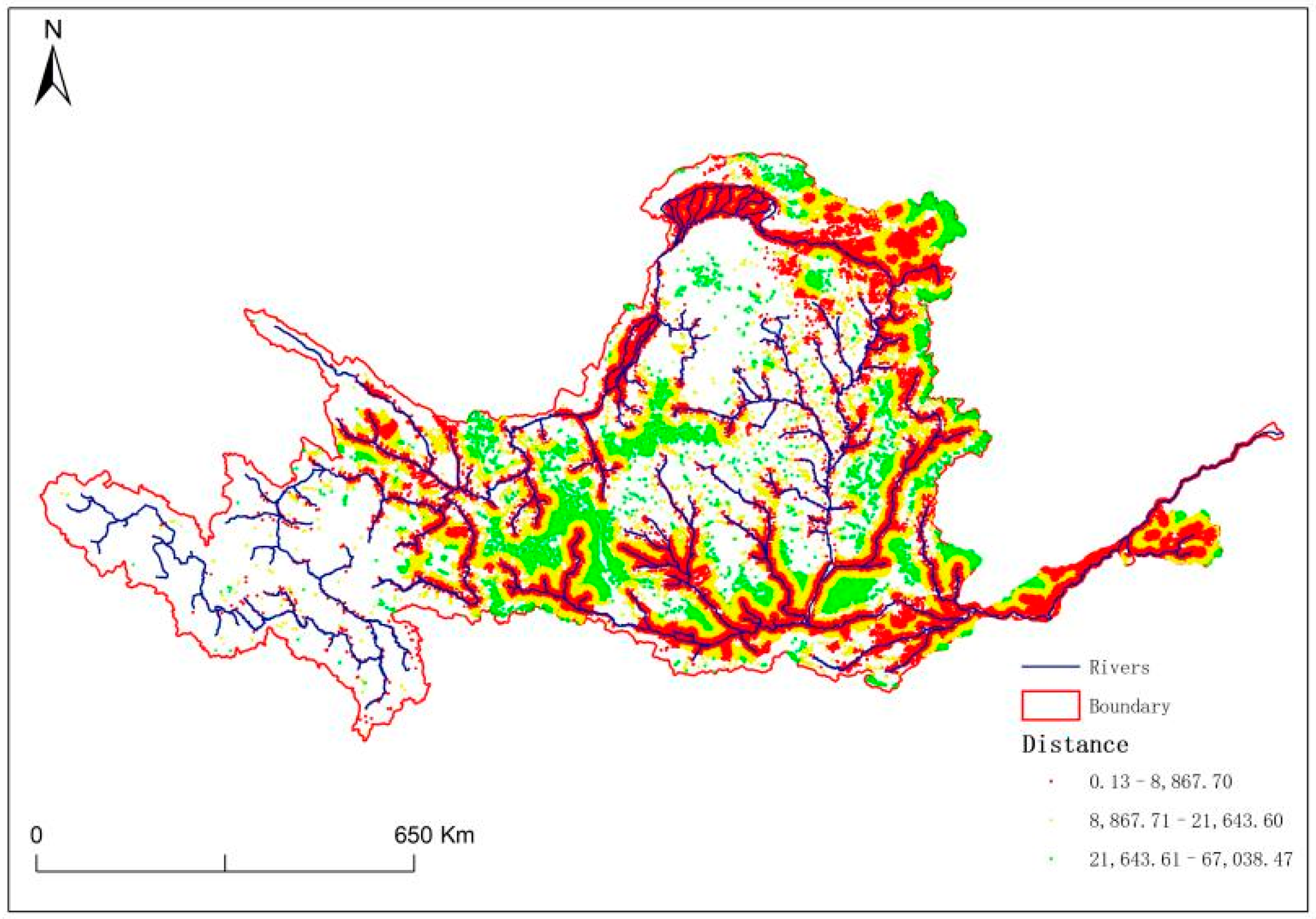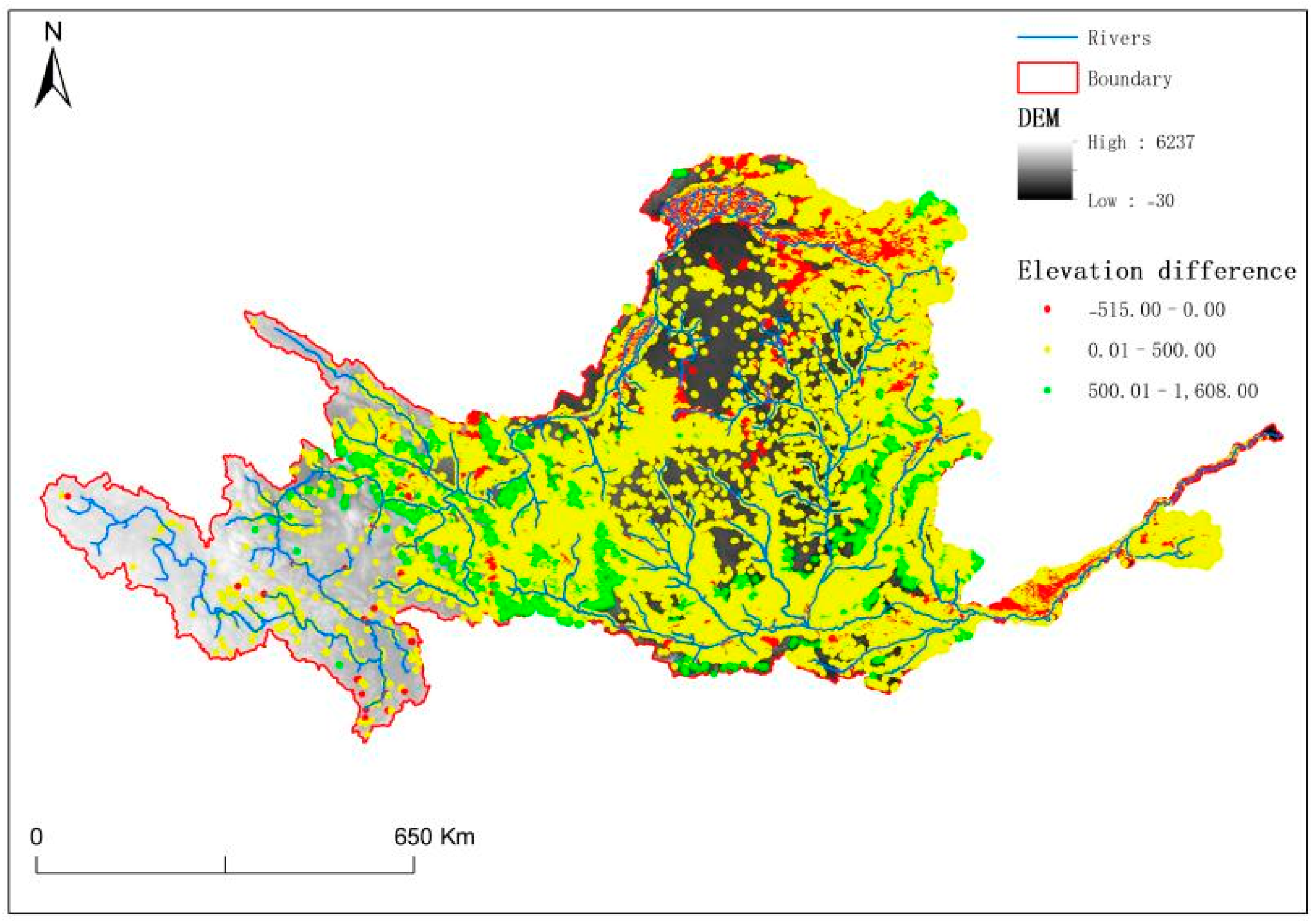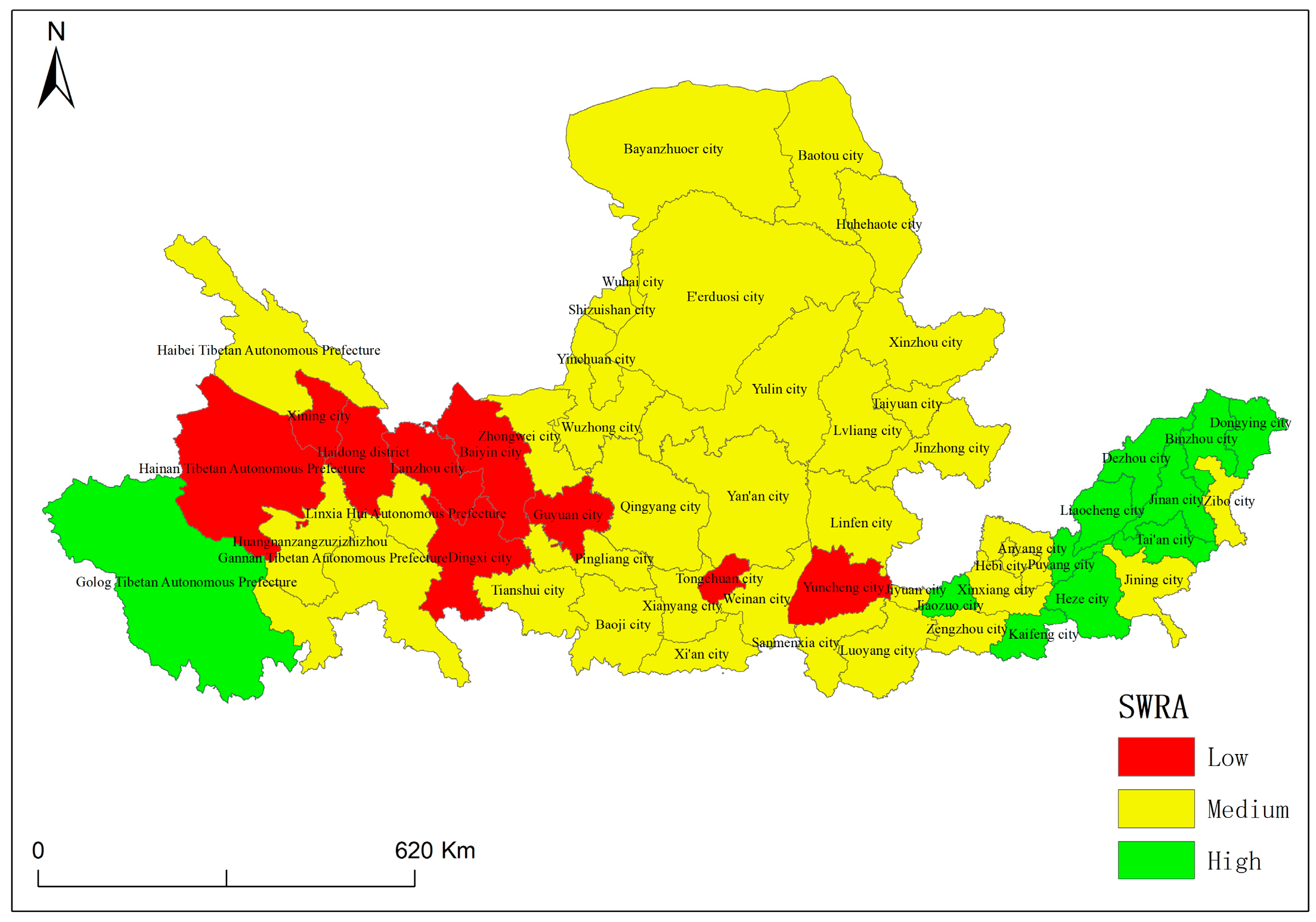Surface Water Resource Accessibility Assessment of Rural Settlements in the Yellow River Basin
Abstract
1. Introduction
2. Materials and Methods
2.1. Study Area
2.2. Materials
2.2.1. Data
2.2.2. Construction of Surface Water Resource Accessibility Model
3. Results
3.1. The Results of SWRA in the Yellow River Basin
3.2. Spatial Distribution Characteristics of SWRA at the Catchment Scale
3.3. Spatial Distribution Characteristics of SWRA at the City Scale
4. Discussion
4.1. The Uncertainty of Indicators of SWRA
4.2. The Implications of SWRA
4.3. The Implications of the Relationship of SWRA and GDP of Primary Industry
5. Conclusions
Author Contributions
Funding
Data Availability Statement
Conflicts of Interest
References
- Li, Y.; Huang, S.; Kong, X.; Han, M.; Wang, M.; Hui, H. Ecological Effects of Surface Water Evolution in the Yellow River Delta. Sustainability 2022, 14, 13544. [Google Scholar] [CrossRef]
- Li, X.Q. Study on measures to enhance integrated water resources management of Yellow River. China Water Resour. 2011, 7, 35–38. [Google Scholar] [CrossRef]
- Song, F.; Yang, X.; Wu, F. Suitable Pattern of the Natural Environment of Human Settlements in the Lower Reaches of the Yangtze River. Atmosphere 2019, 10, 200. [Google Scholar] [CrossRef]
- Zuo, Q.T.; Wu, B.B.; Zhang, W.; Ma, J.X. A method of water distribution in transboundary rivers and the new calculation scheme of the Yellow. Resour. Sci. 2020, 42, 37–45. [Google Scholar]
- Wang, Z.Y.; Huang, J.Y. Research on Spatial Distribution Characteristics of Rural Residential Areas Based on GIS: Taking Fuyu City as an Example. Mod. Agric. Sci. Technol. 2023, 21, 205–208. [Google Scholar]
- Qin, X. The Relationship between Water Accessibility and Economic Development in China. Master’s Thesis, Central China Normal University, Shanghai, China, 2017. [Google Scholar]
- Li, T.; Qiu, S.; Mao, S.; Bao, R.; Deng, H.B. Evaluating Water Resource Accessibility in Southwest China. Water 2019, 11, 1708. [Google Scholar] [CrossRef]
- Xu, L.L.; Tu, Z.F.; Yang, J.; Zhang, C.L.; Chen, X.X.; Gu, Y.X.; Yu, G.M. A water pricing model for urban areas based on water accessibility. J. Environ. Manag. 2023, 327, 116880. [Google Scholar] [CrossRef]
- Li, F.W.; Liu, H.F.; Chen, X.; Yu, D. Trivariate Copula Based Evaluation Model of Water Accessibility. Water Resour. Manag. 2019, 33, 3211–3225. [Google Scholar] [CrossRef]
- Assefa, T.; Jha, M.; Reyes, M.; Srinivasan, R.; Worqlul, A. Assessment of Suitable Areas for Home Gardens for Irrigation Potential, Water Availability, and Water-Lifting Technologies. Water 2018, 10, 495. [Google Scholar] [CrossRef]
- Li, F.W.; Gao, F. Accessibility evaluation of water networks based on network analysis. Water Resour. Hydropower Eng. 2023, 1–13. Available online: https://link.cnki.net/urlid/10.1746.TV.20230922.1452.002 (accessed on 15 June 2023).
- Zhao, L.; Zhang, Z.; Dong, F.; Fu, Y.C.; Hou, L.; Liu, J.Q.; Wang, Y.B. Research on the Features of Rainfall Regime and Its Influence on Surface Runoff and Soil Erosion in the Small Watershed, the Lower Yellow River. Water 2023, 15, 2651. [Google Scholar] [CrossRef]
- Lv, M.Z.; Lu, H.; Yang, K.; Xu, Z.F.; Lv, M.F.; Huang, X.M. Information of Runoff Components Simulated by GLDAS against UNH-GRDC Dataset at Global and Hemispheric Scales. Water 2018, 10, 969. [Google Scholar] [CrossRef]
- Zheng, J.H.; Wang, H.L.; Liu, B.J. Impact of the long-term prevention and land use changes on runoff variations in a humid subregional river base of China. J. Hydrol. Reg. Stud. 2022, 42, 101136. [Google Scholar] [CrossRef]
- Xie, X.Q. The Relationship between Water Accessibility and Economic Development in China. Master’s Thesis, Central China Normal University, Shanghai, China, 2019. [Google Scholar]
- Imiya, M.C.; Erandi, S.; Phub, Z.; Miyuru, B.G.; Denkar, D.; Nitin, M.; Amila, A.; Komali, K.; Upaka, R. Assessing the water quality and status of water resources in urban and rural areas of Bhutan. J. Hazard. Mater. Adv. 2023, 12, 100377. [Google Scholar]
- Yellow River Conservancy Commission of the Ministry of Water Resources. Yellow River Water Resources Bulletin. 2020. Available online: http://www.yrcc.gov.cn/other/hhgb/ (accessed on 22 May 2023).
- Sun, J.W.; Cui, Y.Q.; Zhang, H. Spatio-temporal pattern and mechanism analysis of coupling between ecological protection and economic development of urban agglomerations in the Yellow River Basin. J. Nat. Resour. 2022, 37, 1673–1690. [Google Scholar] [CrossRef]
- Yellow River Conservancy Commission of the Ministry of Water Resources. Yellow River Sediment Bulletin. 2020. Available online: http://www.yrcc.gov.cn/nishagonggao/2020/mobile/index.html#p=1 (accessed on 20 May 2023).
- Shan, Y.M.; Li, H.Y.; Zhang, J.C.; Tang, L.J.; Guo, J.Z.; Wang, G.X.; Wang, J.Y.; Zhang, H.W.; Zheng, H.H. Temporal and spatial evolution and driving force analysis of rural residential distribution pattern in the Yellow River Basin under the background of rural revitalization. Surv. Mapp. Bull. 2024, 1, 96–101. [Google Scholar] [CrossRef]
- Yellow River Conservancy Commission of the Ministry of Water Resources. Atlas of the Yellow River Basin; SinoMaps Press: Beijing, China, 1987; pp. 20–21.
- Wang, Q.Q.; Zheng, W.; Yin, W.J.; Kang, G.H.; Huang, Q.H.; Shen, Y.F. Improving the Resolution of GRACE/InSAR Groundwater Storage Estimations Using a New Subsidence Feature Weighted Combination Scheme. Water 2023, 15, 1017. [Google Scholar] [CrossRef]
- Rodell, M.; Houser, P.R.; Jambor, U.; Gottschalck, J.; Mitchell, K.; Meng, C.J.; Arsenault, K.; Cosgrove, B.; Radakovich, J.; Bosilovich, M.; et al. The global land data assimilation system. Bull. Am. Meteorol. Soc. 2004, 85, 381–394. [Google Scholar] [CrossRef]
- GB/T4754-2011; The National Economical Industry Classification. China, 2011. Available online: https://www.cas.cn/ggfw/tzgg_1/201201/P020120120521186361137.pdf (accessed on 15 June 2023).
- National Bureau of Statistics of the People’s Republic of China. 2021 China Statistical Yearbook; China Statistics Publishing: Beijing, China, 2021.
- Li, H.Y.; Fan, Y.B.; Gong, Z.N.; Zhou, D.M. Water accessibility assessment of freshwater wetlands in the Yellow River Delta National Nature Reserve, China. Ecohydrol. Hydrobiol. 2020, 20, 21–30. [Google Scholar] [CrossRef]
- Bao, R.; Wu, J.; Li, T.; Deng, H. Assessment and Influencing Factors of Water Supply Capacity and Water Resource Utilization Efficiency in Southwest China. Water 2023, 15, 144. [Google Scholar] [CrossRef]
- Wu, Y.Q.; Xu, Y.; Zhao, Y.; Luo, Y.Z.; Lu, J.Y.; Chen, Y.C. Evolution of river network due to urbanization in the Southeast Yinzhou Plain of Yongjiang River Basin, China. J. Clean. Prod. 2022, 379, 134718. [Google Scholar] [CrossRef]
- Anh, N.T.; Can, L.D.; Nhan, N.T.; Schmalz, B.; Luu, T.L. Influences of key factors on river water quality in urban and rural areas: A review. Case Stud. Chem. Environ. Eng. 2023, 8, 100424. [Google Scholar] [CrossRef]
- Liu, J.; Cheng, F.; Zhu, Y.; Zhang, Q.; Song, Q.; Cui, X. Urban Land-Use Type Influences Summertime Water Quality in Small- and Medium-Sized Urban Rivers: A Case Study in Shanghai, China. Land 2022, 11, 511. [Google Scholar] [CrossRef]
- Cao, W.F.; Liu, J.G.; Ceola, S.; Mao, G.Q.; Macklin, M.G.; Montanari, A.; Ciais, P.; Yao, Y.Z.; Tarolli, P. Landform-driven human reliance on rivers in imperial China. J. Hydrol. 2023, 620, 129353. [Google Scholar] [CrossRef]
- Espinoza, S.; Forni, L.; Lavado, A.; Olivera, M.; Tapia, C.; Vega, B.; Balderrama, M.; Escobar, M. Connecting Water Access with Multidimensional Poverty: The Case of Tupiza River Basin in Bolivia. Water 2022, 14, 2691. [Google Scholar] [CrossRef]







| Buffer Distance /km | Number of Rural Settlements | Proportion | Rural Settlement Area/km2 | Proportion |
|---|---|---|---|---|
| 2 | 21,442 | 20.73 | 3388.47 | 21.37 |
| 2–4 | 13,660 | 13.21 | 2481.18 | 15.65 |
| 4–6 | 11,583 | 11.20 | 1966.23 | 12.40 |
| 6–8 | 9621 | 9.30 | 1606.71 | 10.13 |
| 8–10 | 8235 | 7.96 | 1251.94 | 7.89 |
| >10 | 38,881 | 37.59 | 5164.47 | 32.56 |
| Total | 103,422 | 100.00 | 15,858.99 | 100.00 |
| Station | /km | Qs_acc/kg/m2 | E/m | |
|---|---|---|---|---|
| Tangnaihai station | 6.15 | 0.067 | 96.87 | 0.62 |
| Lanzhou station | 7.87 | 0.010 | 210.04 | 0.45 |
| Shizuishan station | 10.68 | 0.003 | 114.88 | 0.46 |
| Toudaoguai station | 8.70 | 0.004 | 54.15 | 0.48 |
| Longmen station | 9.93 | 0.009 | 146.87 | 0.46 |
| Tongguan station | 10.78 | 0.013 | 188.06 | 0.47 |
| Sanmenxia station | 16.53 | 0.012 | 160.52 | 0.45 |
| Xiaolangdi station | 6.06 | 0.013 | 155.74 | 0.49 |
| Huayuankou station | 10.26 | 0.017 | 149.63 | 0.49 |
| Gaosun station | 9.14 | 0.013 | 0.95 | 0.50 |
| Aishan station | 6.74 | 0.020 | 35.61 | 0.52 |
| Lijin station | 7.99 | 0.020 | 80.59 | 0.50 |
Disclaimer/Publisher’s Note: The statements, opinions and data contained in all publications are solely those of the individual author(s) and contributor(s) and not of MDPI and/or the editor(s). MDPI and/or the editor(s) disclaim responsibility for any injury to people or property resulting from any ideas, methods, instructions or products referred to in the content. |
© 2024 by the authors. Licensee MDPI, Basel, Switzerland. This article is an open access article distributed under the terms and conditions of the Creative Commons Attribution (CC BY) license (https://creativecommons.org/licenses/by/4.0/).
Share and Cite
Li, H.; Ma, H.; Zhang, J.; Chen, X.; Hong, X. Surface Water Resource Accessibility Assessment of Rural Settlements in the Yellow River Basin. Water 2024, 16, 708. https://doi.org/10.3390/w16050708
Li H, Ma H, Zhang J, Chen X, Hong X. Surface Water Resource Accessibility Assessment of Rural Settlements in the Yellow River Basin. Water. 2024; 16(5):708. https://doi.org/10.3390/w16050708
Chicago/Turabian StyleLi, Heying, Huiling Ma, Jianchen Zhang, Xueye Chen, and Xuefei Hong. 2024. "Surface Water Resource Accessibility Assessment of Rural Settlements in the Yellow River Basin" Water 16, no. 5: 708. https://doi.org/10.3390/w16050708
APA StyleLi, H., Ma, H., Zhang, J., Chen, X., & Hong, X. (2024). Surface Water Resource Accessibility Assessment of Rural Settlements in the Yellow River Basin. Water, 16(5), 708. https://doi.org/10.3390/w16050708






